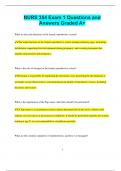NURS 354 Exam 1 Questions and
Answers Graded A+
What are the main functions of the female reproductive system?
✔✔The main functions of the female reproductive system include producing eggs, facilitating
fertilization, supporting fetal development during pregnancy, and secreting hormones that
regulate menstruation and pregnancy.
What is the role of estrogen in the female reproductive system?
✔✔Estrogen is responsible for regulating the menstrual cycle, promoting the development of
secondary sexual characteristics, and maintaining the health of reproductive tissues, including
the uterus and ovaries.
What is the significance of the Pap smear, and when should it be performed?
✔✔A Pap smear is a screening test used to detect abnormal cells in the cervix, which could
indicate cervical cancer or precancerous conditions. It should be performed regularly for women
starting at age 21 or as recommended by a healthcare provider.
What are the common symptoms of endometriosis, and how is it managed?
1
,✔✔Common symptoms of endometriosis include pelvic pain, heavy menstrual bleeding, and
pain during intercourse. Management includes pain relief, hormonal therapy, and sometimes
surgery to remove endometrial tissue.
What is polycystic ovary syndrome (PCOS), and how does it affect reproductive health?
✔✔PCOS is a hormonal disorder that causes irregular periods, excess androgen levels, and cysts
in the ovaries. It can lead to infertility, weight gain, and an increased risk of metabolic conditions
like type 2 diabetes.
What are the signs and symptoms of ovarian cancer, and how is it diagnosed?
✔✔Signs and symptoms of ovarian cancer include bloating, pelvic pain, difficulty eating, and
frequent urination. Diagnosis is often made through a combination of imaging tests, blood tests,
and biopsy.
What is the role of progesterone in pregnancy?
✔✔Progesterone supports pregnancy by preparing the uterine lining for implantation,
maintaining a favorable environment for the developing fetus, and preventing premature uterine
contractions.
What is the difference between a hysterectomy and a myomectomy?
2
,✔✔A hysterectomy involves the removal of the uterus, whereas a myomectomy is the removal
of fibroids from the uterus while preserving the uterus itself.
What are the potential risks and benefits of using hormonal contraception?
✔✔The benefits of hormonal contraception include regulating the menstrual cycle, reducing the
risk of ovarian and endometrial cancers, and providing effective birth control. Risks may include
blood clots, headaches, and changes in mood or weight.
What are the causes and symptoms of a urinary tract infection (UTI) in women, and how is it
treated?
✔✔Causes of UTIs include bacterial infections, sexual activity, and poor hygiene. Symptoms
include frequent urination, burning during urination, and pelvic pain. Treatment typically
involves antibiotics.
What is the role of the nurse in educating patients about self-breast exams?
✔✔The nurse educates patients on the importance of performing regular self-breast exams to
detect changes in breast tissue, instructs on the correct technique, and provides information on
when to seek medical advice if abnormalities are found.
What is the function of the fallopian tubes in the female reproductive system?
3
, ✔✔The fallopian tubes are responsible for transporting eggs from the ovaries to the uterus and
providing a site for fertilization to occur.
What are the common causes of irregular menstrual cycles, and how are they managed?
✔✔Common causes include stress, hormonal imbalances, thyroid disorders, and polycystic
ovary syndrome. Management may include hormonal treatments, lifestyle changes, or addressing
underlying health conditions.
What is the purpose of an ultrasound in gynecology?
✔✔Ultrasound is used to visualize the reproductive organs, diagnose conditions such as ovarian
cysts, fibroids, and ectopic pregnancies, and monitor fetal development during pregnancy.
What is menopause, and what are the typical symptoms?
✔✔Menopause is the natural cessation of menstruation, typically occurring between the ages of
45-55. Symptoms include hot flashes, night sweats, mood swings, vaginal dryness, and changes
in menstrual cycles.
What are the key signs and symptoms of a breast infection (mastitis)?
4




